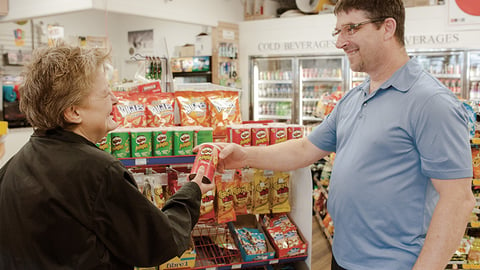Snack attack: A look at what continues to drive the craze to graze
Evolving eating habits, ongoing demographic shifts and the wallet-squeezing effects of inflation continue to drive emerging trends in the snack category, prompting innovation from food manufacturers and grocery retailers alike. And while it might seem intuitive that snacks would be among the first options for trimming household budgets, all indications are that consumers are holding fast to their between-meal noshes.
Mondelēz International’s latest State of Snacking report, conducted in partnership with The Harris Poll, indicates that 75% of consumers “always find room in their budget for snacks.” Focusing closer to home, Innova Market Insights’ Snacking and Healthy Snacking Survey for 2023 reveals more than 70% of Canadians snack at least once a day.
The resilience of snacking is attributed, in part, to consumers today being more likely to opt for multiple, smaller calorie hits throughout the day than the traditional three large meals – and the range of products they are looking to fuel up on continues to expand.
“The lines between snacks and meals continue to blur, offering unique growth opportunities for snacks,” says Kathy Perrotta, vice-president of market strategy and understanding at Ipsos Canada.
Retailers have taken notice. Ontario grocer Farm Boy, for example, is planning an extensive push into snacks over the coming year. “We’re in the process of revamping our grab-and-go snack category right now, because we’re seeing quite a bit of growth there in terms of the need for convenience,” says Alison McFarlane, private label product manager at Farm Boy, adding that customers will soon see more private-label products, such as trail mix, doughnuts and dried fruits, at the checkout.
READ: Snacking in the pandem-flation era
Consumers may be snacking as much as ever, but that doesn’t mean they’re reaching for the same items they used to. Several trends are spicing up the category – in many cases, quite literally – reflecting the influence of global cuisines and the notion that two great ideas can combine to form an even better one.
Global flavours
According to Perrotta, the consumption of sugary snacks is down 3.4% from 2019, while salty snacks are up 6%. Increasingly, Canadians are replacing their sweet teeth with “heat teeth,” with spicy snack eating rising by 11%.
Spicy flavours from all over the globe are driving this trend. Perrotta cites chilis, ghost peppers and Szechuan peppercorns among the tastes consumers are reaching for. Farm Boy’s McFarlane credits millennial and gen-Z shoppers for this adventurous turn.
“We’re seeing more interest, particularly among younger generations, in trying new flavours and I think that’s helped support the growth of these products,” says McFarlane. “Canada has a very diverse population, and people are also travelling more, so they’re very educated in global cuisines.”
McFarlane points to the success of Farm Boy’s private-label fatoush chips as an example of how the retailer has responded. “The flavour is very specific to Middle East cuisine, but it quickly became one of our highest-volume items and caught our eye in terms of what we can look for, globally, for inspiration.”
READ: Despite rising grocery prices, consumers are still budgeting for snacks
Food manufacturers are also ready to meet consumer needs with innovation. Paul Hogan, vice-president and general manager of international, Conagra Brands Canada, says products such as Angie’s BOOMACHICKAPOP Sweet Chili Puffs, which launched this past summer, reflect the growing multicultural influence.
“There’s really a demand in Canada for culturally diverse ingredients, new recipes with global inspiration and a desire for bolder flavours,” he says. “Canadians are looking to satisfy their cravings with something spicy.”
The mash-up
David Grachnik, general manager of snacking at Bimbo Canada, is on a mission to take the company’s Vachon snack cake brand to the next level.
“We talk a lot about how we go from a snack cake provider that has an iconic brand in Quebec to a full-fledged snacking provider that has national presence,” he says. “To do that, we’re going to have to play in different spaces and innovate in different segments.”
Innovation doesn’t necessarily mean creating recipes from scratch. In fact, Grachnik says one of the key steps on Vachon’s path to national snacking prominence is the mash-up – discovering which of the brand’s bestsellers go best together from a flavour perspective.
READ: As consumers embrace global foods, grocers look to diversify their offerings
“Last year, we launched a line of fusions, where we took our top-selling products and fused them together,” says Grachnik, citing combinations of Jos Louis, Passion Flakie and Ah Caramel cakes as examples. “We just launched a strawberry shortcake version of Ah Caramel, which is doing really well, and we’re in the process of thinking through our Takis brand – why couldn’t we create a mixer of all our Takis flavours in one bag?”
Plant power
According to Mondelēz International’s research, 78% of global consumers believe “plant-based snacks are better for the future of our planet.” Add this to an increase in health-conscious shopping – more than half of Canadians intentionally seek out healthy snack options, per Innova Market Insights – and you have a recipe for growth in vegan and vegetarian-friendly snacking.
Dare Foods is one of many companies incorporating this trend into its offerings.
READ: Innovation continues to power the plant-based food movement
“Using real veggies in our products has played an important role in recent product development,” explains Paul Sinden, senior vice-president of sales, marketing and R&D for Dare. Sinden notes the use of real vegetables such as peas, carrots and beets in Dare’s Veggie Crisps and Bear Paws Veggies and Fruits cookies. “Our Breton crackers, Real Fruit gummies and Ultimate Crème Cookies are also all certified plant-based.”
Packed and priced to move
In the shadow of inflation, customers are looking to squeeze maximum value from their snack dollars, whether that means going for volume in large formats or reaching for smaller packs.
“You’re seeing us innovate not only with flavours but... trying to give consumers options on sizes and price points,” says Hogan. “Angie’s BOOMACHICKAPOP is launching on-the-go-size bags, which is not something that previously existed in our portfolio in Canada.”
Grachnick, meanwhile, says Vachon is looking to address this issue while avoiding shrinkflation. “We’re mindful that consumers have a certain price point in mind,” he says. “So, we’re not going to downsize the Jos Louis, we’re going to look at how we can launch a two-pack, for example.”
READ: More than just a treat, consumers are turning to chocolate to boost their mood
Packaging isn’t just about price. Grant Daisley, senior local forager for Pacific Northwest and Canada, Whole Foods Market, says packaging is the clearest way for food manufacturers to address environmentally conscious consumers.
“The snack category is traditionally a huge source of packaging that often isn’t recyclable or compostable,” Daisley says, adding that Humble Potato Chips, a brand packaged in compostable bags and carried in Whole Foods’ Canadian stores, is an example of a product leading the way on this front.
What’s in store
While approaching different snack trends in different ways, food manufacturers are united in shouting out retail partnerships as critical to their products’ success.
Sinden says Dare Foods works with grocers on displays and promotions, while Conagra’s Hogan is thrilled to see the return of shopper marketing campaigns post-pandemic.
“It gives us a great opportunity to create in-store theatre,” says Hogan.
Retailers are happy to oblige. “Once they’re on our shelves, I help equip our suppliers with all the information they need to help them be successful, including in-store demos, in-store signage, promo submissions,” says Daisley.
From research and development to sweet and savoury temptations at checkout, professionals in the snack business are optimistic about the future.
“We’re excited about snacking in general,” says Hogan. “A lot is happening in the space.”
This article first appeared in Canadian Grocer’s November 2023 issue.





